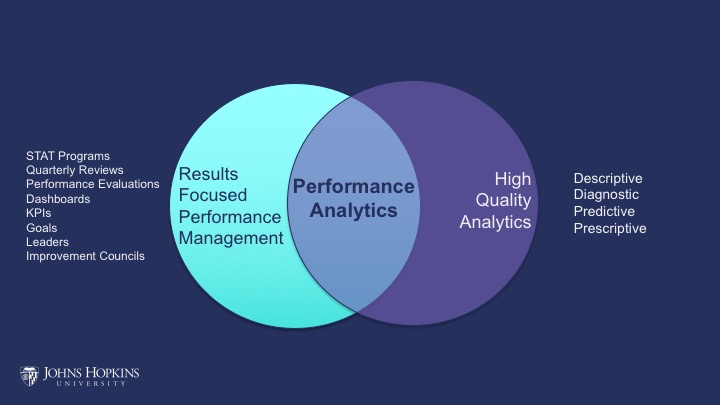What Is Performance Analytics?
Most people in government have at least heard the term performance management but are less familiar with performance analytics. So what's the difference? In theory, nothing. In an ideal world, performance management encompasses high quality analytics. Under some performance frameworks, every organization must have a management system that ensures continuous improvement, demonstrates efficient and effective operations, and engages stakeholders. Analytics should be a key ingredient to all of that work, but it rarely is. Instead, the average person in many governments thinks performance management is having a Stat program, a list of Key Performance Indicators (KPIs), and a pretty dashboard. For too many jurisdictions, performance management has become synonymous with paperwork and quarterly reports to the city manager's office. The Center for Government Excellence (GovEx) is encouraging governments to be explicit about the importance of going beyond the meetings, the metrics, and the reporting - because there are more insights underneath which help public servants redesign services for better outcomes.
So what is performance analytics? As you can see in the diagram below, it is the intersection of results based performance management (as the average person tends to think of it) and high quality analytics. It is the practice of constantly studying how you can do better and inserting those insights into your operational decision making processes, not just the strategic ones. Why does GovEx feel so strongly about this distinction between performance management and performance analytics? Because we have seen analytics make game-changing contributions to the way governments deliver; and we know it is the engine under the hood of a sound performance management program. For many governments, performance management is one way to open the door, get people talking about the importance of data, and asking smart questions. Performance analytics provides answers.

On the management side, organizations still need the key ingredients for success:
| Key Ingredients for Performance Management | Example |
|---|---|
| Executive Champion | Governor, Mayor, City Manager, Department Head |
| Clear Vision & Purpose | Cohesive strategic plan & concrete goals |
| Commitment to Accountability | Clear owners, measures, performance plans |
| Learning Orientation | Peer Benchmarking, Best Practices, |
| Culture of Inquiry | Managers asking "why" and analysts empowered to answer them |
| Engaging Forums | Stat meetings, budget meetings, Data visualizations |
| Commitment to Transparency | open data and open meetings |
On the analysis side, organizations need to deepen the bench of analytical skills in government across multiple dimensions, which means attracting 21st century talent and using modern tools and techniques. Data is everywhere, and accessing it is cheaper and easier than ever. But analyzing it requires these competencies to turn insight into foresight:
| Key Ingredients for Analytics | Example |
|---|---|
| Technological Dexterity | Computer Science skills |
| Problem Solving Orientation | Demonstrated ability to apply complex skills to common problems |
| Analytical Dexterity | Competency in descriptive, diagnostic, predictive and prescriptive analytics |
| Intellectual Curiosity | Demonstrated habit of asking "why?" |
| Creativity | Demonstrated habit of asking "why not?" |
| Effective Communications | The ability to translate information into digestible insights |
| Team Player | Bias toward "we" instead of "me" |